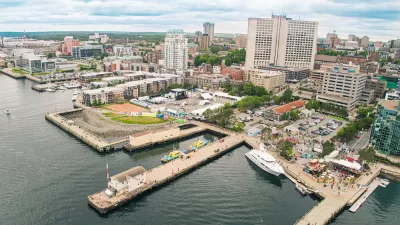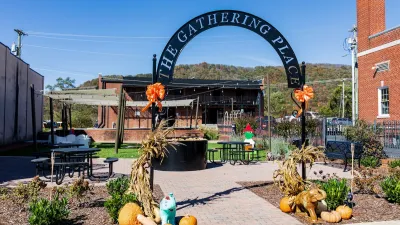How small, incremental changes can create vibrant places.

In an article for Happy Cities, Tristan Cleveland describes the transformation of the Halifax waterfront from a declining post-industrial area to a vibrant hub of public space and amenities that now attracts over 100,000 visitors per year, despite its somewhat inconvenient location.
Cleveland describes the efforts of Build Nova Scotia to improve the waterfront and make it more welcoming to the public, which include simple, affordable steps like adding public furniture and kiosks for small businesses. “Every corner offers a half-dozen things to do—thanks to the cumulative impact of decades of small investments.”
Cleveland contrasts the success of the Waterfront with Halifax Commons, a vast green space in the middle of the city that is easily accessible but often underused. The difference, for Cleveland, is the small things. Although the city has big plans for the future of the park, “It is not currently anyone’s job to ask, each spring, whether any areas of the park are underused, and what can be done to bring life to them.”
This underscores a common problem in park planning. “Cities tend to make major investments in headline projects, but struggle to spend on small, cheap projects.” Cleveland argues that these small, incremental investments in placemaking “need not be expensive, and they generate disproportionate value in new developments and businesses.”
FULL STORY: How Halifax built the most vibrant waterfront in Canada: Decades of small changes

Study: Maui’s Plan to Convert Vacation Rentals to Long-Term Housing Could Cause Nearly $1 Billion Economic Loss
The plan would reduce visitor accommodation by 25,% resulting in 1,900 jobs lost.

North Texas Transit Leaders Tout Benefits of TOD for Growing Region
At a summit focused on transit-oriented development, policymakers discussed how North Texas’ expanded light rail system can serve as a tool for economic growth.

Why Should We Subsidize Public Transportation?
Many public transit agencies face financial stress due to rising costs, declining fare revenue, and declining subsidies. Transit advocates must provide a strong business case for increasing public transit funding.

How to Make US Trains Faster
Changes to boarding platforms and a switch to electric trains could improve U.S. passenger rail service without the added cost of high-speed rail.

Columbia’s Revitalized ‘Loop’ Is a Hub for Local Entrepreneurs
A focus on small businesses is helping a commercial corridor in Columbia, Missouri thrive.

Invasive Insect Threatens Minnesota’s Ash Forests
The Emerald Ash Borer is a rapidly spreading invasive pest threatening Minnesota’s ash trees, and homeowners are encouraged to plant diverse replacement species, avoid moving ash firewood, and monitor for signs of infestation.
Urban Design for Planners 1: Software Tools
This six-course series explores essential urban design concepts using open source software and equips planners with the tools they need to participate fully in the urban design process.
Planning for Universal Design
Learn the tools for implementing Universal Design in planning regulations.
City of Santa Clarita
Ascent Environmental
Institute for Housing and Urban Development Studies (IHS)
City of Grandview
Harvard GSD Executive Education
Toledo-Lucas County Plan Commissions
Salt Lake City
NYU Wagner Graduate School of Public Service





























